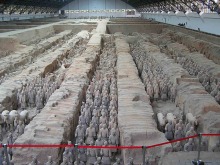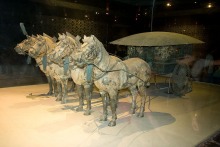One of the most spectacular sites in archaeological history rests in the country of China. It is the tomb of China’s first emperor, Qin Shihuang, who lived more than 2000 years ago. Though his rule would be short and his dynasty last only a few years longer than his life, he left behind a legacy that would change the way future emperors thought of China and steer them in the direction of uniting the various kingdoms under one ruler. The other part of his legacy is the Mausoleum of Qin and its massive army of terracotta warriors and chariots, each designed uniquely to display the face of the living warrior that served as model.
This wonder lay beneath the earth for over 2000 years, only rediscovered in 1974. Since then three excavations have been made and resulting in the unearthing of more than 8000 warriors along with countless numbers of other artifacts. Recently, the third excavation has been underway and now more warriors will join the ranks of Qin’s unliving army.
The latest excavation brought forth more than 300 artifacts, including 120 warriors, 12 horses and 2 chariots, as well as various weapons and drums. Also included in the find was a shield - the first of this type of artifact to be found at the site. Some of the warriors found are of higher rank and thus their statues show a finer degree of craftsmanship.
This new round of finds displays evidence of a fire sometime in the past. Most of the warriors were burned and some melted almost completely.
Researchers have concluded that the fire was of a high enough temperature that is had to have been man-made. There is also evidence that many of the statues were smashed deliberately. Archaeologists are putting this puzzle together, but reason that the tomb was most likely looted and burned by the military leader who overthrew Qin’s dynasty following his death.Many of the new warriors are, despite the fire, better preserved than previous finds. They retain some of the paint which was used to decorate them following their construction, whereas all other statues have lost that detail due to the effects of time. Some of the found statues appear to be entertainers of some sort, having no weapons or armor.
The scale of the Qin Mausoleum is still unknown. Even with three excavations, archaeologists reckon that they have only unearthed a fraction of what lies beneath the ground. More finds are likely in the future, and with them perhaps some new revelations about Emperor Qin and the historical times in which he lived.

